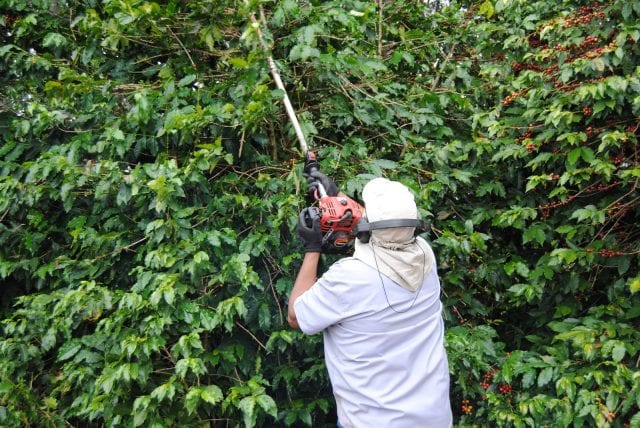Delightful specialty coffee needs eminence at each phase of the supply chain. It means coffee beans from the perfectly ripen cherries only can make it into the end product.
Multiple ways are accessible to collect coffee cherries. Handpicking or mechanize coffee harvest, grower’s selection will influence the quality of coffee, making cost, environmental as well as social impression.
What Is Hand Picking?
Most countries use Manual coffee picking or Handpicking that involves laborers harvesting the coffee beans by hand. Usually in farms, workers pull-off the entire branch from its base, and thereby collecting the cherries that get dropped. This method is simply called strip picking. Such farms normally yield commodity-grade coffee.

Hand Picking coffee beans on a sunny day. Coffee farmer is harvesting coffee berries.
The farms that target the specialty market will only collect the ripe cherries. This will make certain sweeter, more compound flavors in the cup. The pickers do multiple reaps so they can collect the cherries as they get ripened. This is commonly called as selective picking.
What Is Mechanized Harvesting?
Mechanized harvesting is common in huge farms of many countries like Brazil and Hawaii. It’s linked mainly with commodity coffee. However, some farms make use of it to yield specialty coffee also. There are two different machines employed for mechanized picking.
Small machines that comprise a long rod with two huge vibrating hands are called Derricadeiras .After placing a sheet beneath the coffee tree, the derricadeira machine will be switched on and get it up to the coffee branches. The vibrations shake the cherries to fall down and get collected in the sheet.

The stripping machines are much bigger and are often driven on the farm. They can harvest more quantities of coffee at the same time. The rotating and vibrating rods in the machine knock and make the cherries lose and get collected in an attached bin in the machine.

Machine in the field harvesting coffee in the plantation of Brazil.
A Stripping machine is a time-saver, but it can be only used in relative flatlands.
Picking Method & the Quality of Coffee
The significance of only using ripe coffee cherries cannot be overstated. Under or over-ripe cherries may add an unpleasant taste to the cup, and can even be considered faults. Balance, complexity, and consistency will be decreased. And if a coffee sample has too many flaws, it will eliminate that coffee from specialty grade.
For this reason, most specialty coffee farmers choose selective picking. It’s usually recommended by specialty shoppers, as strip manual picking and mechanized picking tend to also reap under-ripe and over-ripe cherries.
Coffee pickers can also collect information about the coffee tree, how to take care of the leaves, branches, pest-infected cherries, and the early indicators of the plant disease. This understanding is crucial for observing plant health and coffee quality, and regular crop checks should be made.
And since the cherries at the top of the tree inclines to ripen earlier, another way is to harvest the taller branches first. Then, later on in the term, the lower branches can be reaped.
Which is the Most Productive Method?
Productivity and Quality are the two factors that must be considered by the Coffee growers. Both the elements cannot be seen separately, the longer it proceeds for coffee cherries to be collected, the more the chances of them becoming over-ripe and even dropping from the branch.
Mechanization could be regarded as further dynamic since the machines take the coffee faster and cover more plot. This is predominantly relevant on larger farms.
On the other hand, it can lead to more spending of time and effort post-processing, reducing efficiency. It could also cause lower crop harvests if under-ripe coffee cherries are avoided post-harvesting.
With the selective hand-picking method, it does not need to remove under-ripe cherries from the harvest during processing (though it’s a worthy idea to still use water tanks/floatation to remove faulty cherries). Furthermore, the immature cherries can be kept on the branch to ripe and be harvested later, raising the crop yield.
However, labor scarcities could lead to coffee being undone and, consequently, lost yields and profits.
Methods employed in the Ethiopian Farms
In Ethiopia, Coffee is harvested using the hand-picking method. As you already know it is a highly laborious process and requires the efforts of a skilled workforce to pick the perfect cherries for a delicious quality cup. Cherries are hand-picked by the diligent farmers of Ethiopia, based on the color that indicates their maturity or ripe level. They usually choose even and medium to rich red cherries for the blend. Green under-ripe or immature fruits lack the sugar content and tastes grassy whereas over-ripe ones render a fermented or sour taste to coffee, so both are avoided by the skilled coffee growers while picking.
One can decide between hand-picking and mechanized harvesting based on their convenience and limitations. No matter the type of harvesting method you use, make sure that the cherries that are collected finally should be the fully matured ones, needed for a sweet and stimulating brew.
Remember, cautious cherry-picking certainly enhances the quality of your coffee.
